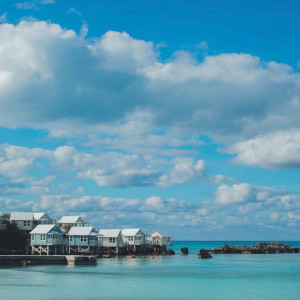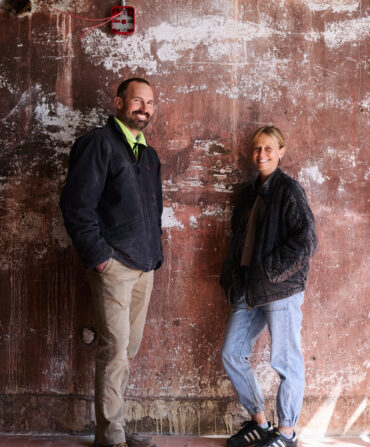This year, Rock City in Lookout Mountain, Georgia, marks thirty years of its holiday display, Enchanted Garden of Lights. As generations of travelers who’ve heeded the call of the iconic red-and-black barn advertising can attest, Rock City is awash with earthbound beauty, from the expansive views to the geologic formations complemented by native-plant landscaping designed by co-founder Frieda Carter in the 1930s. Carter cultivated the park’s more fantastical legacy, too: Obsessed with European folklore, she imported hundreds of antique terra-cotta gnomes to decorate the gardens’ serpentine pathways and hired sculptor Jessie Sanders to develop Fairyland Caverns and Mother Goose Village, vast dioramas depicting scenes of classic fairy tales and nursery rhymes that glow under black lights set deep in limestone caves.

After nearly a century, the rocks of Rock City look much the same, but these man-made features, fragile from the beginning, are increasingly vulnerable to the ravages of time, the elements, and an occasional rowdy guest. Their upkeep is managed by Will Jackson, senior manager of innovation, who has drawn on his background in set design and a personal fine-arts practice since joining Rock City in 2006. Until moving to new digs in 2024, he and his Innovation Team repaired shattered gnomes and revived aging fairy-tale critters in the same workshop Frieda Carter built for Jessie Sanders in the 1930s. Here, Jackson shares the unusual joys and challenges of keeping these generations of magic alive.
What do you call the gnomes? Are they “assets” or “creatures” or something?
They’re gnomes. I don’t know if that’s boring or if that’s funny. They’re gnomes, and we think of them as gnomes. I genuinely believe they have magic in them. I believe in the resonance of objects—I’m gonna get a little weird.
No, please. Go ahead.
If a person puts time and attention to an object, it carries some piece of meaning, and it is more than just the sum of its literal parts. And so these creatures—having come from Germany, having been sculpted and cast from terra-cotta and brought here by Frieda Carter, our founder, and then placed in the gardens, and having seen millions of people come to the gardens and have experiences—I believe they do carry meaning and resonance in them. So they’re not just an asset. There are gnomes, there are trolls, there is statuary from our fairy tales. Snow White, or Cinderella, or Goldilocks, or whoever they are—we refer to them by name.

What kind of care do the statues in Fairyland Caverns and Mother Goose Village require?
Being a Hydrocal figure—which is essentially like plaster of Paris—in a cave is a pretty rough endeavor. Plaster is a porous material. If you’ve ever been in an old house and you look at the ceiling and you see the cracks and the blistering, that happens when water absorbs in. As the plaster starts to pull in moisture, it starts to pop the paint off the surfaces. And if it goes down deep enough—there’s actually a steel armature inside those figures. Over time, that steel begins to rust and it starts to blister. We have to keep them sealed really well and trap the moisture.

Sealing is a challenge because the paint is all UV-reactive. Most sealers will defeat UV reactivity because their job is to protect against UV sunlight damage. Any sort of a traditional varnish will actually inhibit the UV from working, and the statues stop glowing. Damar varnish is the only one we’ve found that works. It’s like an old-school, old masters’ oil painting varnish, which means it’s not as durable as most modern formulations of sealers, so we have to do it more frequently.
Over time, we’re gonna have to do more preservation for those spaces, starting with 3D scanning and making sure we’ve got a digital representation of everything before we lose them. We’re also trying to pull as much moisture out of the air as we can. We’ve got an air replacement system in the cave now that’s pulling moisture out at a much better rate than it used to. And in the meantime, we go in and we keep the statuary clean and preserve what we can.

There’s nature, and then there’s people. Can you tell me about some of the damage caused by guests?
We’ve had people get into the scenes and stage photos with themselves, or get on top of Little Red Riding Hood’s Wolf, that sort of thing. These incidents are not super frequent, but they do happen. We’ve taken steps to make that very difficult for people to do because, first of all, it’s dangerous for them. And second of all, we can’t really replace these figures in the way we would need to if somebody really busted them up.
What does it feel like when you see the damage?
It’s heartbreaking. Have you ever had your car broken into? That’s what it feels like. It feels unfair and it feels wrong. The violated feeling, it stays with you. I just really feel a sense of responsibility for these things. Everybody on our team does. They’re proud of this long history. And so when you see that happen, it’s hard. Luckily it really is pretty rare.
Sometimes y’all have to make repairs while the guests are still in there, and it’s kind of a teaching moment.
That’s actually wonderful. A lot of the figures can be moved out of there, but some of them are so fragile that we have to do all the work on-site. We have signage, and we’ll dress such that guests can see us, because one of the hardest things about working in the dark environment is scaring people. It’s a little jarring to see this forced-perspective scene and a giant human in there. Everything is extremely distorted, all the figures are really grotesquely misshapen, because they’re meant for that one point of view. So people want to know what’s going on. We tell them what the statues are made out of, or we tell them about Jesse Sanders, or about Frieda’s love of gnomes. And most of the time, people feel really connected—like, “Wow, very cool.” That person-to-person storytelling, I think, is one of the most important things we get to do.

What prompts a piece of statuary being taken to the workshop?
A lot of the figures in the cave, because they can’t be moved, we have to repair them on-site. But when we can pull them out, we will. The cool thing about some of the older pieces being terra-cotta casts is that we sometimes have two or three copies of a particular piece. So if one has broken his ankle, we’ll take him to the hospital, and there’s another one that we can put in his place. These casts are original production models from the 1880s. So there will be a particular pose we can pull out and paint to match the existing, then take our time to do the conservation of, say, fixing a leg. Those kinds of repairs are not the sort of thing we can do over the course of an afternoon in the scene.
When an object has been broken and repaired, how does that change its resonance?
There are gnomes who have become the Ship of Theseus, where changes that were made in the 1980s or the seventies have taken it to a point where it is not its original self anymore—it is now something new. But that gnome has its own meaning and relevance, too. We may not put them into a scene with some of Frieda’s originals anymore. They may go into a different sort of scene, like the Carnival of Gnomes, which is an update that was made in the sixties. We have to make the choice on a gnome-to-gnome basis.
Does it ever get creepy, all the little eyes staring at you?
Actually, one of my favorite things is to be here at night by myself. I’ve done haunted house design, so I’m kinda desensitized to heebie-jeebies. But being in the gardens at night, or being down in the cave by myself at night, is a real privilege. It’s a beautiful place.








